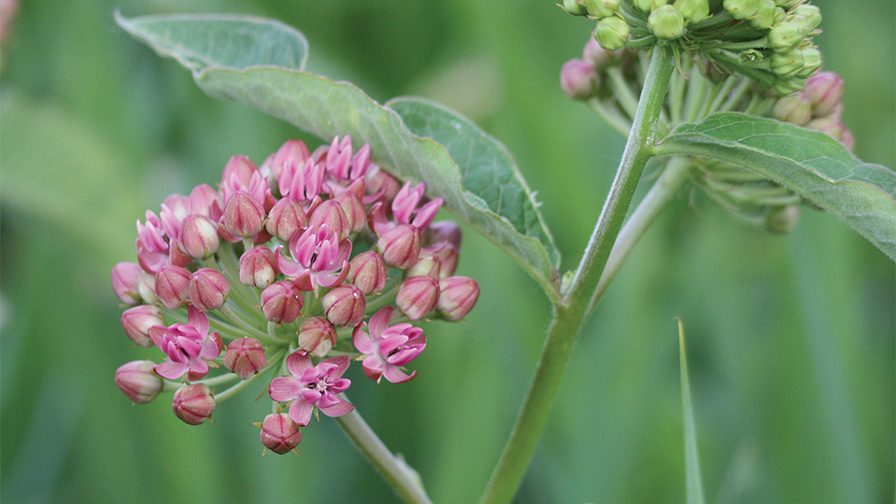How Growers Can Benefit From the “Monarch Economy”

The U.S. Geological Survey estimates that the migrating Monarch population requires 3.62 billion milkweed stems to sustain itself annually.
Lately, I’ve been chewing on something like a caterpillar chews through a leaf: starting at the margins and tracing a path until all that remains is the fiber. For all the hubbub about pollinators and a lot of good science to back it up, the industry has dived into the idea headlong with a flood of marketing and new varieties that strike at the easy target of human emotion. Who wouldn’t want to plant a few things in service to the very essential creatures that make honey, apples, almonds, chocolate, and tequila (don’t forget those bats) possible?
Monarch Butterfly Numbers Are Declining
It goes without saying that the panda of pollinators — the Monarch butterfly — has declined significantly in the lifetime of most Millennials, to the tune of around 90%. The oldest of the generations might remember seeing them at recess or in the parks near their elementary schools, while the youngest heard about them in science class and have probably seen more photos online in the last few years than they have real butterflies in person. Census data of overwintering populations in 2016 and 2017 shows numbers bouncing around with cause for cautious optimism. It makes you wonder if anything we’re doing is working, or is it just good weather and happenstance?
There are more than 70 species of Asclepias in the North American flora. More of them than not have a place in managed landscapes. Are people really planting more milkweed (the word could sell itself these days)? It seems so, but who’s producing them? Are consumers planting landscape plugs or 1-gallon containers, or are they haphazardly tossing seed into the wind in hopes that a couple germinate? Are public-sector projects accounting for most of the new milkweed in landscapes? Let’s cut to the chase — what are we as an industry doing to generate the supply of milkweed needed to plant the next green revolution? As a high-value 1-gallon crop, the economics seem obvious.
Supply Doesn’t Equal Demand for Milkweed
The U.S. Geological Survey estimates that the migrating Monarch population requires 3.62 billion milkweed stems to sustain itself annually. Currently, they estimate only 1.34 billion stems exist, suggesting that upward of 1.8 billion additional milkweed stems are needed in the U.S. to return numbers to historic averages (and yes the math doesn’t add up, but that’s accounting for population attrition and statistical margins of error).
I first learned of this number in a meeting last fall of Plant.Grow.Fly., an Iowa-based conservation initiative led by Blank Park Zoo in Des Moines and supported by nearly 60 nonprofits and government entities throughout the state. What struck me throughout the course of the meeting as the only horticulturist in the room was how little discussion there was about how to actually produce milkweeds or how to get plants to consumers in a successful way. Conservationists understand ecological systems. Horticulturists understand plants. We shouldn’t be expected to do each other’s work.
It goes without saying that the opportunities for collaboration are huge. We don’t have to be insect biologists, but we need to advocate for thoughtful, smart plantings that do more than look good. Tossing handfuls of milkweed seeds might seem like an easy, effortless way to get people hooked, but the chances for success are relatively low. We can do better, and well-intentioned gardeners deserve it.
We Can Do Better With Variety Selection
Further, why haven’t we deepened the deck of new varieties specifically selected for their pollinator cachet? (This question is somewhat philosophical, as I believe on good information that there’s a lot of attention being paid to the subject, even if it hasn’t borne fruit).
Sure, many new varieties these days come packaged in ecological goodness, whether we actually know it or not. There are varieties that have empirically established reputations for attracting more pollinators than generic comparisons (Phlox paniculata ‘Jeana’ and Veronicastrum virginicum ‘Lavendelturn’ come to mind).
Annie White and Leonard Perry’s research from the University of Vermont sheds light on this subject, documenting cultivars that outperform wild ecotypes, while also showing that there isn’t a bulletproof pattern among or within genera. We can’t overstate what we don’t know, and nature doesn’t often fit tidily into taglines or sales pitches. The bottom line for breeders looking to work the angle — there’s a lot of potential in native species to select for long bloom periods, which often equates to high nectar production and thus the increased likelihood of pollinator services.
Further, volumes of research are underway as a new passion for horticulture and ecology raises new and serious questions for how we produce plants and ultimately use them in landscapes. Do animals perceive plants differently based on their origins? What plants do pollinators prefer in urban environments? Are there differences between pollinator occurrences and diversity based on urban versus rural environments? The questions are almost as exciting as the answers.
Back to Milkweed
It’s still early in the season yet, but offhand conversations with several growers around the country suggest steady or increasing demand for Asclepias. One perennial producer in Maryland said 2017 was the strongest year for A. tuberosa, with 2018 sales down only a few percentage points in comparison to the running average over the last few years, likely due to weather. I’d love to hear from more growers about their strategies and how they plan to increase pollinator plant production in the next year. I’m not done with this leaf yet — there’s much more here to munch on.










